How To Draw A Context Diagram
What is a data flow diagram (DFD)?
A picture is worth a thousand words. A Information Flow Diagram (DFD) is a traditional way to visualize the information flows within a organisation. A neat and articulate DFD can depict a good amount of the system requirements graphically. Information technology can be transmission, automated, or a combination of both.
It shows how information enters and leaves the organisation, what changes the data and where information is stored. The purpose of a DFD is to show the scope and boundaries of a system equally a whole. It may exist used as a communications tool betwixt a systems analyst and whatever person who plays a function in the arrangement that acts every bit the starting betoken for redesigning a system.
It is commonly beginning with a context diagram as level 0 of the DFD diagram, a elementary representation of the whole system. To elaborate further from that, nosotros drill downward to a level ane diagram with lower-level functions decomposed from the major functions of the system. This could go along to evolve to become a level ii diagram when further analysis is required. Progression to levels 3, iv and so on is possible but anything beyond level three is not very common. Please carry in listen that the level of detail for decomposing a detail role depending on the complication that function.
DFD Diagram Notations
Now we'd like to briefly introduce to you a few diagram notations which you'll come across in the tutorial beneath.
External Entity
An external entity can represent a human, system or subsystem. It is where sure data comes from or goes to. Information technology is external to the system we study, in terms of the business process. For this reason, people used to draw external entities on the edge of a diagram.
.png)
Procedure
A process is a business activity or office where the manipulation and transformation of data accept identify. A procedure can exist decomposed to a finer level of details, for representing how data is being processed within the process.
.png)
Data Shop
A data store represents the storage of persistent data required and/or produced past the procedure. Here are some examples of information stores: membership forms, database tables, etc.
![]()
Information Menstruation
A data flow represents the flow of data, with its direction represented by an arrowhead that shows at the cease(s) of flow connector.
.png)
What will nosotros exercise in this tutorial?
In this tutorial, nosotros will prove you how to draw a context diagram, along with a level ane diagram.
Note: The software we are using here is Visual Prototype. You are welcome to download a free 30-day evaluation copy of Visual Paradigm to walk through the instance below. No registration, electronic mail accost or obligation is required.
How to Describe Context Level DFD?
- To create new DFD, select Diagram > New from the toolbar.
- In the New Diagram window, select Information Flow Diagram and click Next.
- Enter Context as diagram proper noun and click OK to confirm.
- We'll now describe the first process. From the Diagram Toolbar, drag Procedure onto the diagram. Name the new procedure Organization.

- Adjacent, permit's create an external entity. Identify your mouse pointer over System. Press and drag out the Resource Catalog button at the superlative right.
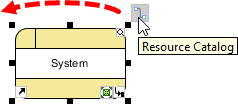
- Release the mouse button and select Bidirectional Data Flow -> External Entity from Resource Catalog.

- Name the new external entity Customer.

- At present we'll model the database accessed by the arrangement. Use the Resource Itemize to create a Data Store from System, with bidirectional data menstruation in betwixt.

- Name the new data store Inventory.
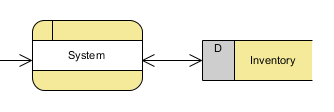
- Create two more information stores, Client and Transaction, as shown below. We have only completed the Context diagram.
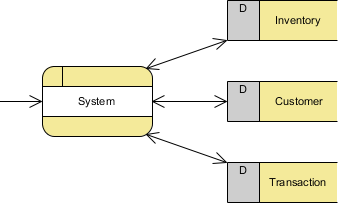
How to Draw Level i DFD?
- Instead of creating another diagram from scratch, we will decompose the System process to form a new DFD. Right-click on Organisation and select Decompose from the popup menu.
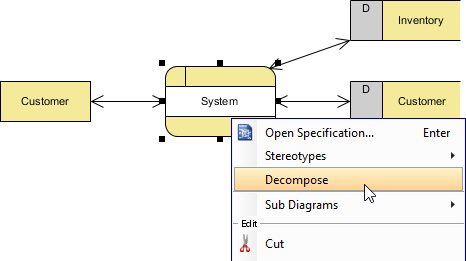
- The data stores and/or external entities connected to the selected process (System) would be referred to in the level i DFD. And so when you are prompted to add them to the new diagram, click Yes to ostend.
Note: The new DFD should await very similar to the Context diagram initially. Every element should remain unchanged, except that the System procedure (from which this new DFD decomposes) is at present gone and replaced by a blank infinite (to be elaborated). - Rename the new DFD. Right-click on its background and select Rename.... In the diagram's name box, enter Level ane DFD and press ENTER.
- Create three processes (Process Social club, Send Good, Issue Receipt) in the center as shown below. That is the former spot for the Organisation process and we place them there to elaborate System.
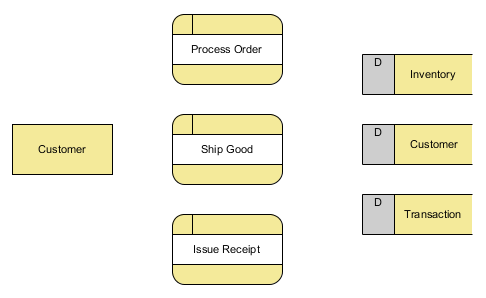
Wiring with connection lines for information flows
The remaining steps in this department are about connecting the model elements in the diagram. For instance, Customer provides order information when placing an social club for processing.
- Place your mouse arrow over Customer. Elevate out the Resource Catalog icon and release your mouse push button on Process Club.
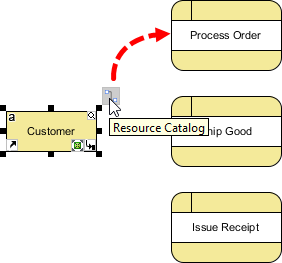
- Select Data Menstruum from Resources Catalog.

- Enter gild information has the caption of catamenia.
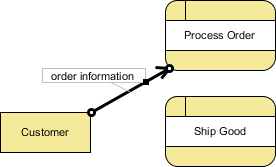
- Meanwhile, the Process Order process too receives client information from the database to process the society.
Use the Resources Itemize to create a data catamenia from Customer to Process Society.

Optional: You tin can characterization the data menstruum "client information" if you like. But since this data menstruum is quite cocky-explanatory visually, we are going to omit information technology here. - Past combining the order information from Client (external entity) and the customer information from Customer (information shop), Process Gild (procedure) then creates a transaction tape in the database. Create a data flow from Process Society to Transaction.

Drawing Tips:
To rearrange a connectedness line, place your mouse arrow over where you want to add a pivot signal to it. You lot'll then come across a bubble at your mouse pointer. Press and drag it to the position desired.
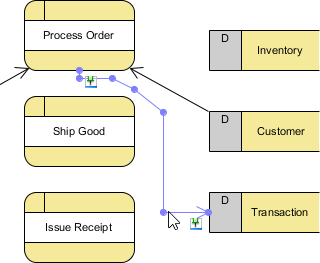
Up to this point, your diagram should look something like this.
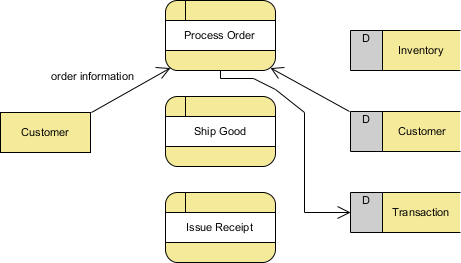
- Once a transaction is stored, the aircraft process follows. Therefore, create a data flow from Procedure Order (process) to Send Good (process).
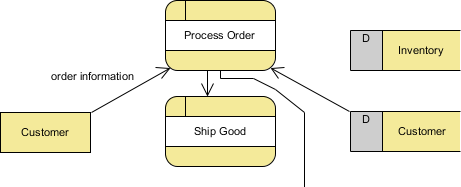
- Ship Skilful needs to read the transaction data (i.e. The order number to pack the right production for commitment. Create a data flow from Transaction (data store) to Ship Skilful (procedure).

Note: If there is a lack of infinite, experience free to move the shapes around to brand room. - Transport Good also needs to read the customer data for his/her aircraft address. Create a data period from Customer (information store) to Transport Good (procedure).

- Send Skilful then updates the Inventory database to reflect the goods shipped. Create a data flow from Ship Skillful (process) to Inventory (data store). Name it updated production record.
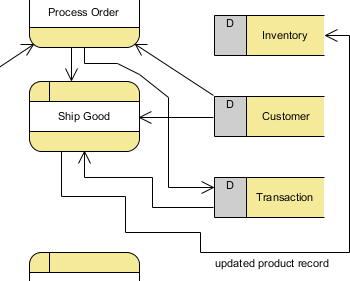
- Once the order arrives in the client's hands, the Event Receipt procedure begins. In information technology, a receipt is prepared based on the transaction record stored in the database. So let'south create a data flow from Transaction (data shop) to Consequence Receipt (process).
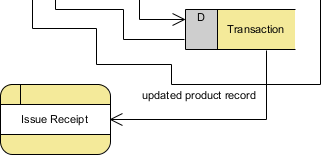
- Then a receipt is issued to the customer. Let's create a data catamenia from Issue Receipt (process) to Customer (external entity). Name the data flow receipt.
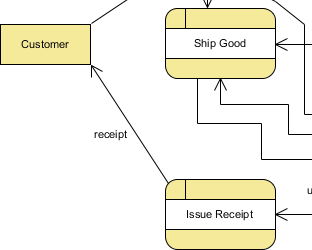
You have but finished drawing the level ane diagram which should look something like this.
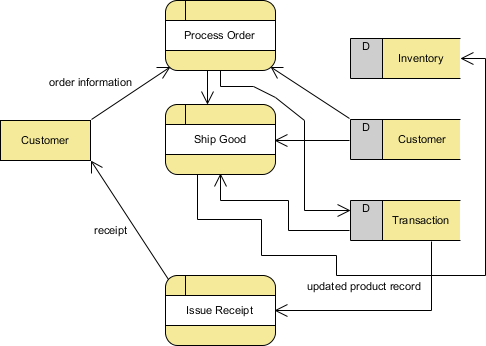
How to Improve a DFD's Readability?
The completed diagram to a higher place looks a bit rigid and busy. In this section, nosotros are going to make some changes to the connectors to increase readability.
- Right-click on the diagram (Level 1 DFD) and select Connectors > Curve. Connectors in the diagram are now in curve lines.
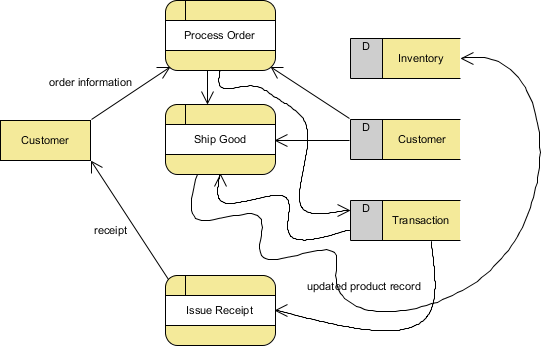
- Move the shapes effectually so that the diagram looks less crowded.

More than DFD Examples
The list below directs you to various Information Flow Diagram examples that cover unlike businesses and problem domains. Some of them consist of the use of multiple context levels.
Source: https://www.visual-paradigm.com/tutorials/data-flow-diagram-dfd.jsp
Posted by: weaverkess1936.blogspot.com


0 Response to "How To Draw A Context Diagram"
Post a Comment